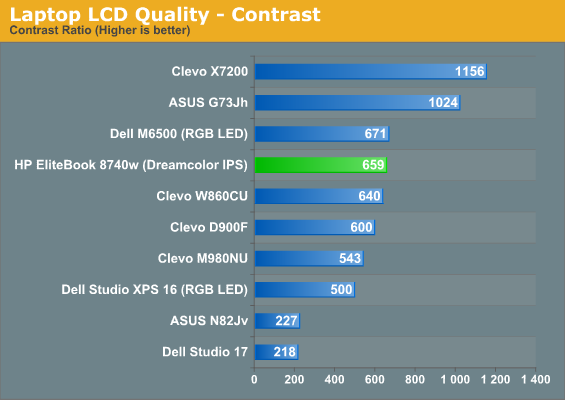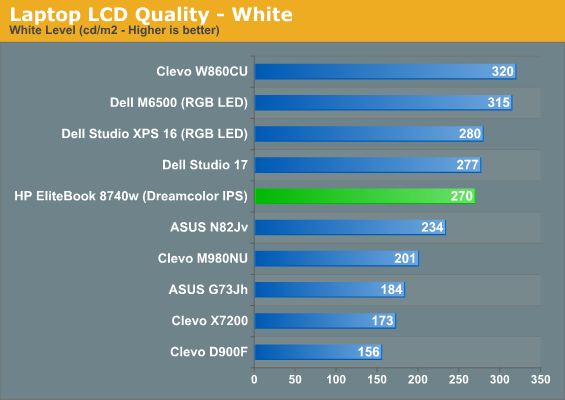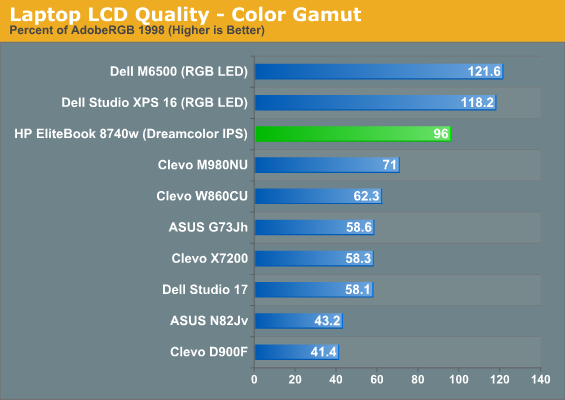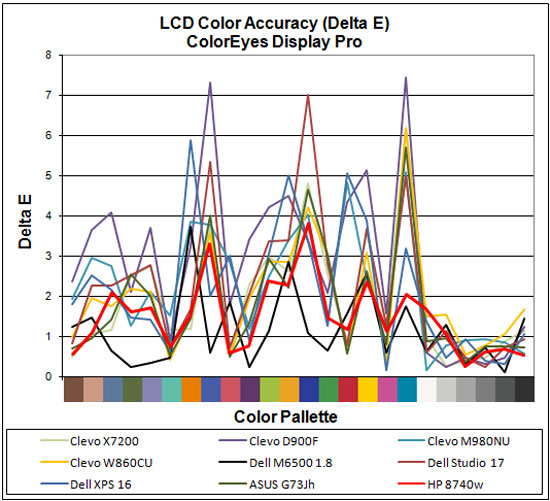HP EliteBook 8740w: IPS on the Go
by Dustin Sklavos on December 8, 2010 3:10 AM EST- Posted in
- Laptops
- IT Computing
- Intel
- HP
- EliteBook
- Mobile Workstation
- Quadro
- NVIDIA
The $550 DreamColor IPS Upgrade
And here we get to the tough part. HP touts the DreamColor matte IPS panel option in their EliteBook 8740w with good reason: it's an IPS panel in a market where anything other than a TN is exceedingly rare. The problem is that it does command a premium, and a massive one: $550 ($570 with the webcam). Dell doesn't charge anywhere near as much for their screen upgrades, so we really want to know if we're going to get what we pay for with the DreamColor.







You asked for an IPS panel, and you got one. The DreamColor produces incredibly accurate color that basically covers the AdobeRGB 1998 color space. Contrast is excellent and of course you get fantastic viewing angles as well. Black and white levels are both quite nice. Overall it's a great-looking panel.
That said, it still has trouble surpassing the Dell notebooks, particularly the Precision M6500, which boasts both superior color gamut and color accuracy by our measure. It gets worse, too: that upgrade to the M6500 is about $200 cheaper...but then it's not IPS. Realistically, few people will need the higher Dell Gamut, but you're still looking at almost twice the upgrade cost to get IPS in place of TN, and we'd say the M6500 RGB LED panel is already priced quite high. $600 can get you a pretty awesome 24" desktop LCD, but a 17" laptop panel with similar characteristics still costs more.
Subjectively it must be said that while the DreamColor panel on the EliteBook 8740w is very attractive and miles away from what we're used to seeing, even after calibration colors can feel oversaturated. 100% Adobe RGB gamut is good for those that need it, but for everyone else working in sRGB color space, that's the penalty. Yes, we're used to seeing dismal, washed out color when testing notebooks, but the 8740w's colors are still too bright at times—and it must be said, the 120% gamut of the M6500 is even worse in this respect. Though our measurements don't totally bear this out, there's definitely some black crush going on as well. I use a calibrated Dell 2709WFP on my desktop, a screen most agree has some issues with oversaturation, and it seems positively mild compared to how bright the colors on the 8740w's DreamColor can be.
Make no mistake, this is a fantastic panel; however, it may not be the game-changer we were looking for, especially not when the Precision M6500 is hanging around. $300 will go from standard LCD to high color gamut WUXGA, but you're still stuck with TN panels; the additional $250 will add the viewing angles that IPS provides. As mentioned in our recent look at an old ThinkPad T42, a good laptop display can be nigh on impossible to find, and HP provides one. It just so happens that the display costs as much as (or more than) a larger 24" LCD that could sit on your office desk.














63 Comments
View All Comments
slacr - Wednesday, December 8, 2010 - link
"Of course, being a Quadro it does bring all of the secret sauce that NVIDIA packages with its workstation class cards"What does this secret sauce do these days, the only documents i've found are rather old and talk of anti-aliasing in CAD software. Other "CUDA capable" cards offer GPU-assistance in for example Adobe CS and CAD software is no longer particularly bound by cpu so the only benefit i've seen is the larger video RAM which can be found on normal cards anyway, so what does the price premium actually buy?
JarredWalton - Wednesday, December 8, 2010 - link
I believe it's line anti-aliasing, better OpenGL drivers (with ISV certification for various applications), and some 64-bit FP performance enhancements. To my knowledge, all of this stuff is available in the standard NVIDIA GPUs, but they only enable it on the Quadro drivers.DanNeely - Wednesday, December 8, 2010 - link
FP64 is the big one. ATI's high end GPUs are limited to FP64 performance that's 1/5th of FP32. Nvidia's high end consumer cards only have 1/.8th, while GT100/110 quadro's are 1/2 (the highest possible without throttling FP32). For scientific computing this is enough to justify paying several times as much as a consumer card so nVidia hobbles the GeForces to support sales of Tesla boxes.mczak - Wednesday, December 8, 2010 - link
FP64 is really for tesla though. Maybe workstation cards still have the full performance FP64 enabled, but honestly noone would care. It's pretty much line aa still I think, plus geforce cards also have artificial limitation on (non-tesselated) geometric throughput.carsandcomps - Thursday, December 9, 2010 - link
The secret sauce is overlay planes and 3D wireframe performance. Consumer cards are great for tesselated 3d with texture maps, but most are pretty horrible when there a hundreds of thousands of 3D wireframe edges in a view.You are correct about the drivers being better also. While a crazy "flareout" or glitch from a surface is no big deal in a game, it is a show stopper on a real 3D engineering model. Not that I am a Nvidia fanboy, but their workstation class drivers have always been better in my opinion.
sheltem - Wednesday, December 8, 2010 - link
I'm pretty sure the Quadro 5000M is the same exact card as the 480M. The main difference is the drivers. You can either hack the driver files to trick it into a 480M (or vice versa) or mod the bios.I actually have the Elitebook 8740w, but with an AMD FirePro 7820. I hacked the Catalyst Mobility drivers to work with my FirePro 7820M.
Zan Lynx - Monday, December 13, 2010 - link
You can hack it, but there's more to it than just the drivers.The Quadro and Tesla hardware goes through a much more careful test process.
The gaming hardware will produce calculation errors fairly often.
The Quadro and Tesla hardware: hardly ever.
yakugo - Monday, March 21, 2011 - link
How/what did you do to hack your 7820 drivers so catalyst control center would work? i have a dell m6500 with the m7820 card. Could you email me at mp3moeny@hotmail.comThanks,
-Aaron
mschira - Wednesday, December 8, 2010 - link
Well, I do appreciate a decent screen, and you know what I might even be ready to pay 550$ extra for it, but a 17" laptop?What's the point for that?
They never fit onto anything else but a desk. Even 15" laptops are a pain to carry around.
So why not get a decent all in one PC like an iMac ?
And why, oh why is there no smaller laptop that offers a decent screen?
M.
damianrobertjones - Wednesday, December 8, 2010 - link
Why an iMac instead of the other oem machines?